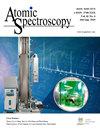以16O2-为主要同位素的射频离子源纳米模拟Pb/Pb和U/Pb测年
IF 2.3
2区 化学
Q1 SPECTROSCOPY
引用次数: 0
摘要
NanoSIMS具有高空间分辨率的能力,可以使用最近建立的射频(RF)氧离子源在亚微米尺度上进行Pb/Pb和U/Pb测年。然而,与使用大几何次离子质谱法(LG-SIMS)相比,使用16o -作为主光束时Pb +的二次离子产率相对较低,这限制了Pb/Pb和U/Pb定年的精度。在这项研究中,我们在CAMEA NanoSIMS 50L离子探针上使用16o2 -作为主要氧源,我们获得了锆石中Pb的灵敏度约为12 cps/nA/ppm。锆石参考物质M257和OG1的Pb同位素组成与参考值一致,Pb/Pb年龄在小于2 μm × 2 μm的目标兴趣区域(ROI)内不确定度为~ 3%。根据Pb/U与UO 2 /U功率关系或Pb/UO与UO 2 /UO功率关系进行Pb/U校正,得到不确定度< 2.2%的Pb/U年龄。采用16o2 -作为射频离子源的主要种类是一种精确测定U/Pb年龄的可能方法。它的规模,与低珍贵外星本文章由计算机程序翻译,如有差异,请以英文原文为准。
Pb/Pb And U/Pb Dating By NanoSIMS With The Radio-Frequency Ion Source Using 16O2- As The Primary Species
: NanoSIMS features a capability of high spatial resolution, which allows for Pb/Pb and U/Pb dating at the submicron scale, using a recently established radio-frequency (RF) oxygen ion source. However, the secondary ion yield of Pb + is relatively low when using 16 O - as the primary beam species compared to that obtained using large-geometry secondary ion mass spectrometry (LG-SIMS), which limits the precision of Pb/Pb and U/Pb dating. In this study, using 16 O 2- as the primary species with an RF oxygen source on a CAMEA NanoSIMS 50L ion probe, we acquired Pb sensitivity in zircon of approximately 12 cps/nA/ppm. Analyses of the zircon reference materials M257 and OG1 resulted in Pb isotopic compositions consistent with their reference values and Pb/Pb age with an uncertainty of ~3 % for the target region of interest (ROI) smaller than an area of 2 μm × 2 μm. Pb/U age with an uncertainty < 2.2% was acquired via Pb/U correction based on the Pb/U vs. UO 2 /U power relationship or the Pb/UO vs. UO 2 /UO one. The adoption of 16 O 2- as the primary species for the RF ion source is as a possible approach for accurate U/Pb age determination. It scale, with low precious extraterrestrial
求助全文
通过发布文献求助,成功后即可免费获取论文全文。
去求助
来源期刊

Atomic Spectroscopy
物理-光谱学
CiteScore
5.30
自引率
14.70%
发文量
42
审稿时长
4.5 months
期刊介绍:
The ATOMIC SPECTROSCOPY is a peer-reviewed international journal started in 1962 by Dr. Walter Slavin and now is published by Atomic Spectroscopy Press Limited (ASPL). It is intended for the rapid publication of both original articles and review articles in the fields of AAS, AFS, ICP-OES, ICP-MS, GD-MS, TIMS, SIMS, AMS, LIBS, XRF and related techniques. Manuscripts dealing with (i) instrumentation & fundamentals, (ii) methodology development & applications, and (iii) standard reference materials (SRMs) development can be submitted for publication.
 求助内容:
求助内容: 应助结果提醒方式:
应助结果提醒方式:


